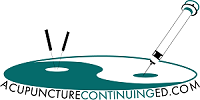COLORADO
COLORADO ACUPUNCTURE LAW AS IT RELATED TO POINT INJECTION THERAPY
Colorado Revised Statutes 2016
Title 12 Professions and Occupations
Article 29.5 Acupuncturists
Acupuncture Practice Act
12-29.5-102. Definitions.
(3.3) “Injection therapy” means the injection of sterile herbs, vitamins, minerals,
homeopathic substances, or other similar substances specifically manufactured for
nonintravenous injection into acupuncture points by means of hypodermic needles used primarily for the treatment of musculoskeletal pain. Permissible substances include saline, glucose, lidocaine, procaine, oriental herbs, vitamin B-12, traumeel, sarapin, and homeopathic substances. “Injection therapy” includes the use of epinephrine and oxygen as necessary for patient care and safety, including for the purpose of addressing any risk of allergic reactions when using injection substances.
12-29.5-102.5. Injection therapy – training – substances – rules. (1) A licensee shall obtain the necessary training as determined by the director prior to practicing injection therapy.
(2) Notwithstanding section 12-42.5-305, a licensee who has received the necessary
training to practice injection therapy may obtain substances for injection therapy from a registered prescription drug outlet, registered manufacturer, or registered wholesaler. An entity that provides a substance to a licensee in accordance with this section, and who relies in good faith upon the license information provided by the licensee, is not liable for providing the substance.
(3) The director shall promulgate rules to implement this section that include the
necessary training for a licensee to practice injection therapy and a list of substances that a licensee may obtain for injection therapy. In promulgating the rules, the director shall consult with knowledgeable medical professionals and pharmacists.
12-29.5-115. Effective date – applicability. This article shall take effect July 1, 1989,
and shall apply to practicing acupuncturists on or after January 1, 1990.
Colorado Acupuncture Rules and Regulations
https://drive.google.com/file/d/0BzKoVwvexVATVzljQ0lBX2hvM00/view
Rule 10 Injection Therapy
- Definitions. For purposes of this rule only:
- The Director recognizes that “Injection therapy” is the stimulation of acupuncture points, including trigger points(historically known as “AHSHI” points), by the injection of saline, sterile herbs, vitamins, minerals, homeopathic substances, glucose, lidocaine, procaine, and sarapin, or other similar substances specifically manufactured for nonintravenous injection by means of hypodermic needles.
- Except as restricted by paragraph (C) of this rule, an acupuncturist with an active license may practice injection therapy in the treatment of patients in his or her care
- Requirements to Practice Injection Therapy. The acupuncturist shall:
- possess a Colorado acupuncture license in good standing;
- hold a current Clean Needle Technique Certificate through the NCCAOM (or successor organization); and
- be current in basic life support (BLS) or cardiopulmonary resuscitation (CPR) approved by the American Heart Association or American Red Cross;
- complete educational coursework covered in subsection D.
- Acupuncturists employing injection therapy shall use only those substances and techniques for which they have received training. Required Educational Coursework shall include:
- Anatomy and Physiology
- Acupuncture physical exam and differential diagnosis;
- Acupuncture point location, including underlying anatomy;
- Acupuncture needling technique;
- General injection safety;
- Acupuncture point injection therapy;
- Pharmacology; and
- Clean Needle Technique.
- For the use of injectable substances prepared from oriental herbs, completion of training in Chinese herbology and injection of Chinese herbal injectables is required.
To demonstrate satisfying the training requirements in Chinese herbology and injection of Chinese herbal injectables the Director will accept NCCAOM, or a successor organization’s, certification in Chinese herbology and/or certification in Oriental Medicine.
- For the use of substances listed in (E)(3)(a)(12-17), instruction on the use of inhaled O2 and IM epinephrine for emergency use is required.
- Permissible Substances
- An acupuncturist shall comply with all federal and state laws that pertain to obtaining, possessing and administering any drug;
- A substance shall only be approved for use if procured in compliance with all federal and state laws;
- The following drugs are authorized in the modes of administration that are specified except as limited or restricted by federal or state law:
- Permissible substances that an acupuncturist may obtain for injection therapy as
permitted per Section 12-29.5-102(3.3), C.R.S and as permitted by the
Director per Section 12-29.5-102(3), C.R.S. are:
(1) Dextrose;
(2) d-glucose;
(3) Enzymes except urokinase;
(4) Glucose;
(4) Homeopathic Substances (to only include those that are within the US
Pharmacopia);
(5) Hyaluronic Acid;
(6) Minerals;
(7) Saline;
(8) Sarapin;
(9) Sodium chloride;
(9) Sterile water;
(10) Traumeel;
(11) Vitamins;
(12) Cyanocobalamin;
(13) Lidocaine;
(14) Marcaine (Bupivacaine Hydrochloride) with or without epinephrine;
(15) Oriental Herbs
(16) Procaine ; and
(17) Vitamin B-12.
- Patient safety.
- Acupuncturists shall have an adverse event/emergency plan in place.
- An acupuncturist practicing injection therapy of substances listed in (E)(3)(a)(12)-(17) shall be equipped and trained to treat patients with oxygen and epinephrine. The oxygen and emergency epinephrine kit shall be on site where injection therapy utilizing substances with potential allergic side effects are being rendered.
- An acupuncturist authorized to practice injection therapy shall not inject any substance intravenously.
- Acupuncturists shall show current medical malpractice coverage for this procedure and maintain coverage.
- It is the acupuncturist’s responsibility to only inject substances that are listed in subsection
E and are explicitly covered by the acupuncturist’s insurance policy obtained in
compliance with Section 12-29.5-104(6), C.R.S.
Relicense Education Requirements
Colorado Department of Regulatory Agencies
